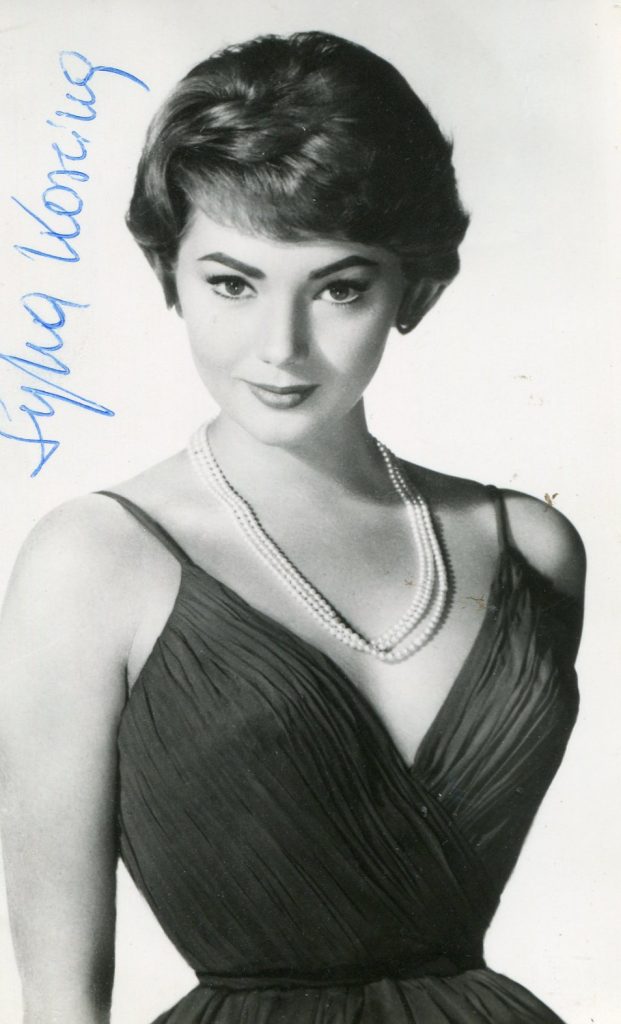
SYLVIA KOSCINA OBITUARY IN “THE INDEPENDENT”.
Sylva Koscina was a beautiful Yugoslav actress who was featured in many Italian epics of the late 1950’s onwards. She starred opposite Steve Reeves in “Hercules”. By the mid 1960’s she was making international films including two films in Hollywood, “The Secret War of Harry Frigg” with Paul Newman and “A Lovely Way to Die” with Kirk Douglas. She did not remain in the USA and returned to European filmmaking. She died aged 61 in 1994.
Sweet, smiling, curvaceous Sylva Koscina was a symbol of the Italy of the Sixties, incarnating the optimism of the years of the Italian economic miracle.
Throughout that period, Koscina was Italy’s version of a Hollywood glamour queen, and movie posters never failed to enhance her ample bosom. But she was no maneater. Even at the peak of her success, there was often a touch of sadness in the famous smile.”She had the typical melancholy of the Slavs,” recalled Dino Risi, who directed her in a series of comedy roles. “I never managed,” she herself admitted, “to unite the actress and the woman in a single person.” Most of her friends agreed Koscina’s problem was that she always fell in love with the wrong man. They believed that “She always wanted to redeem them and it isn’t easy to save someone who doesn’t want to be saved.
Koscina was born in Zagreb and brought to Italy during the Second World War by her sister, who had married an Italian. In Naples, she graduated from high school and studied physics at the local university.
Her film career began by chance, after one of her teachers had persuaded her to be among the girls who greeted the winner of one of the stages of the bicycling Tour of Italy. The photograph of the beautiful young woman kissing the ace cyclist Rik Van Steenbergen ended up in all the Italian papers, attracting the attention of various Italian film-makers.
Pietro Germi, one of Italy’s most famous and most controversial directors, picked Koscina to play opposite himself in his neo-realist masterpiece Il ferroviere (“The Railwayman”, 1956), in which he portrayed a railwayman struggling against poverty and injustice.
In 1957, Koscina starred in The Labours of Hercules, by Pietro Francisci, until then an obscure director, the film that started the revival of a typically Italian genre and made mythological giants such as Hercules, Ursus, Maciste and Samson famous throughout the world. The first of the Hercules series, Le fatiche di Ercole, like many of its followers, grossed a fortune in Italy and in the US, luring many American businessmen into investing in the genre and turning the Cinecitta studios, in Rome, into Hollywood on the Tiber. This film and others of the same genre made Koscina one of Italy’s best-loved stars.
Afterwards, Koscina starred in many, mostly second-rate,comedies that were popular for over a decade, including Dino Risi’s Nonna Sabella (1957) and Luigi Zampa’s Ladro Lui, Ladro Lei (1958), where she starred opposite Alberto Sordi.
Italy’s cinema then centred on the male and, between 1959 and 1968, most starring roles went to a small group of actors including Ugo Tognazzi (62 films), Enrico Maria Salerno (40), Alberto Sordi (34), Vittorio Gassman (33) and Nino Manfredi (32). It is easier to understand Koscina’s popularity if one considers that, with 46 films, she was the only female who starred in as many films as the top men.
In 1965, she played the role of Juliet (Giulietta Masina)’s sister in Federico Fellini’s Giulietta degli Spiriti (“Juliet of the Spirits”), probably the most important of all her films.
Koscina had a brief, largely unsuccessful stint in Hollywood, during which she starred opposite Kirk Douglas in A Lovely Way to Die (1968).
As an actress, Koscina took herself very seriously, and was made fun of by friends for her habit of always referring to herself in the third person. But, by the time she had learnt to act, her career was almost over. Unlike other Italian actresses, including the likes of Sophia Loren and Silvana Mangano, whose careers were boosted by their producer-husbands Carlo Ponti and Dino de Laurentiis, Koscina received no help from her own husband, Raimondo Castelli, who only pushed her to act in as many films as possible.
Koscina had created a major scandal in Italy when she was indicted for bigamy, after a Mexican marriage to Castelli, who was already married. The marriage ended badly, some years later.
“For too long I worked like a madwoman, doing eight to ten films a year, just to make money and then spend it all,” Koscina once said. “I played the role of the vamp without ever believing in it.”
In the 1970s, Koscina became the first Italian actress to appear in the American edition of Playboy magazine. She appeared in various television series in the Seventies and the odd film or two in the Eighties. In recent years, she was a frequent guest ontelevision talk-shows where she was invited as an “ambassadress of beauty and good taste”.
Koscina contracted breast cancer a few years ago. After a first operation, she had always minimised the seriousness of her condition and had not hesitated to talk about her sickness, in order to send a message of hope to other women

